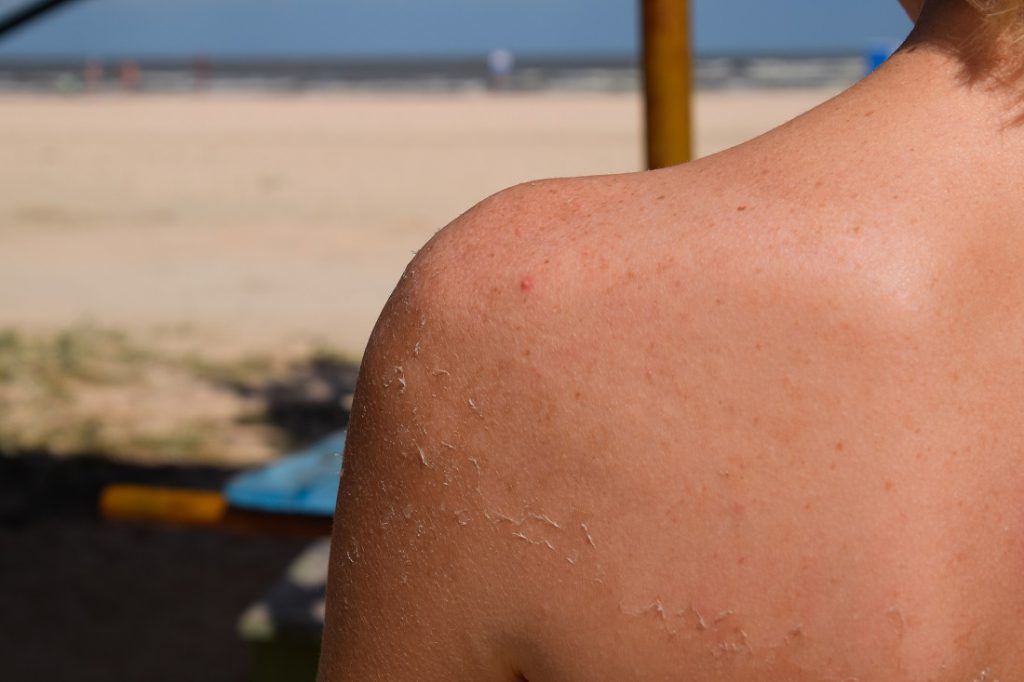Sunburns, and all the symptoms that come with them, are not only unappealing, but also dangerous. While most of us know that getting sunburned increases our risk of developing skin cancer, and that it should be avoided, accidents do happen. And sometimes the resulting damage comes with side effects we don’t know how to handle. Natalie Curcio, MD, MPH, FAAD, a board-certified dermatologist practicing in Nashville, explains why our skin acts the way it does when it sustains a sunburn, and what we can do about it.
What Happens to Skin When It Gets Burned?
“A sunburn is a type of burn caused mainly by ultraviolet B radiation from the sun,” says Dr. Curcio. “It occurs after a body’s defenses are overwhelmed by too much exposure to this UV light. The toxic reaction that occurs is a sunburn.”
Dr. Curcio says the extent of a sunburn depends on your skin type — people with lighter skin are at a higher risk for a serious sunburn — and the amount of exposure to UV rays you’ve received. First-degree sunburns can be red and painful to the touch, but affect only the epidermis, the outermost layer of the skin. Burns of this severity should heal within a few days.
A second-degree sunburn is more serious. “These sunburns are severely red and make the skin swell up and blister,” says Dr. Curcio. “This means that the dermis (a deeper layer of skin) and nerve endings have been damaged. This type of sunburn will take longer to heal than a first-degree burn and will likely be more painful.”
Unfortunately, both of these types of burns can start to peel (usually about three days after you sustain them). So what can you do to combat this?
When a Burn Takes a Turn
When skin begins to peel, it is a sign the body is trying to rid itself of damaged cells. You can use many of the same techniques that apply to a non-peeling sunburn to get some relief. Dr. Curcio says that getting out of the sun and treating a sunburn as soon as you notice it is the first step for healing sun-burned skin. “To relieve pain, you can take cold showers or baths and take ibuprofen or aspirin,” she says. “Also, the best thing to do is moisturize the area with an aloe-vera or soy-based product. Moisturizing will help soothe sunburned skin, but be careful to avoid petroleum-based or other oil-based creams. These may trap heat and make your sunburn even worse. In addition, don’t forget to drink extra water to prevent dehydration.”
Once skin starts to peel, she adds, continue to moisturize your skin, which helps peeling skin heal faster. Be sure to take extra care to protect and cover peeling skin as it heals.
What Not to Do
It may be tempting to try to exfoliate a peeling sunburn in an attempt to remove the dead skin, but Dr. Curcio says this isn’t a good idea. “Do not pull off your peeling skin, and avoid active exfoliation,” she says. “Instead, allow it to slough off your body on its own. Peeling usually stops when the burn has healed — about seven days for mild to moderate burns.”
Finally, it’s imperative to practice effective sun protection while a peeling burn is healing. “After sustaining a sunburn, your skin is more sensitive to additional UV damage,” Dr. Curcio says. “Wear protective clothing that covers your skin when outdoors.”
In addition to covering up with clothing, you can seek shade and avoid peak sun hours (10 AM to 4 PM) to help you sidestep additional sun damage while your skin heals. If you take care of it and avoid additional sun exposure, a mild to moderate burn should heal in around seven days.
But the best way to avoid all this trouble is, you guessed it, avoiding sunburn in the first place. “Exposure to UV light is the most preventable risk factor for sunburn and for all skin cancers,” Dr. Curcio says. “Protect your skin from those harmful rays and always remember to wear a broad-spectrum sunscreen with an SPF 30 or higher!”





